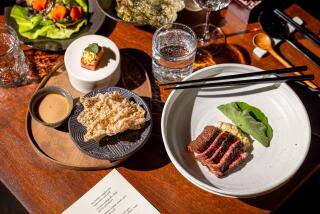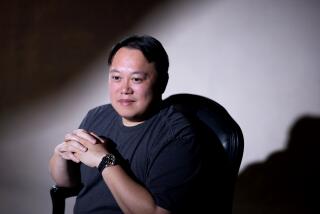For the Best, They Go to Yo : Fishermen Swear by Rods Made by Gardena Craftsman, Then They Help Him Out in Tough Economic Times
- Share via
A shrine to saltwater fishing is hidden behind a humble storefront on Western Avenue in Gardena, between an art gallery and an animal hospital.
A collection of autographed 8 x 10 photographs lines the entrance. Some are faded with age, some tattered at the edges, but all show people with unusually large fish and an apparent devotion to the proprietor:
“Yo--thanks for the great tackle.”
“Yo--a great rod, a great fish, a great fight.”
“Yo--the rods did it.”
Follow the photos and you arrive at a counter manned by a slight, soft-spoken, chain-smoking man of 67 years: Yoshiro Yoshida--”Mr. Yo” himself.
“Custom orders only,” a sign says--meaning, custom saltwater fishing rods, which have generated a cult of disciples for Yo’s craftsmanship.
“He makes the best custom rods in the world,” says Frank Lo Preste, who runs long-range boats from San Diego. “There’s no doubt about that.
“A lot of guys, when they say custom rod, that means they’re going to wrap it in custom colors. When you get a custom rod from Yo, it takes into consideration the distance from your elbow to your wrist, your height, your physique, you pulling power, your age.
“If it’s a woman, she’s not just a woman, she is a short woman with short arms, and he builds the rod accordingly . . . something she can handle the fish with.”
Seems logical, but only the most dedicated anglers understand the importance of a rod’s dynamics in a long fight with a large fish. David Manella used one of Yo’s rods in a 75-minute fight with an all-tackle world-record yellowfin tuna of 395.3 pounds off Mexico last February. The Toluca Lake lawyer is 5 feet 8 and 135 pounds.
*
Ordinarily, Yo has a six-week backlog of orders, but last Saturday he really had his hands full.
Old friends, with support from the saltwater sportfishing industry, organized a pilgrimage to his shop. About 1,100 people passed through the small store, clogging the aisles, scooping up line and lures at irresistible 10% discounts and spilling out into the back parking lot for seminars and displays of tackle from various manufacturers.
Steve Tsujiuchi, wearing an orange Yo’s Tackle T-shirt, pulled the details together, and Lo Preste arranged the seminars by saltwater angling experts. Yo’s business hadn’t been so good in a long time.
“This area in particular had gotten hit hard by (layoffs in) the aerospace industry,” Lo Preste said. “A lot of us have been around Yo for years and years and he’s always given, given. We wanted to do something good for Yo.”
Said Tsujiuchi: “I’ve known Yo since I was a little kid. I’m just one of the fishing bums that hang out here. Most of us have been coming here since we were teen-agers. My first fishing rod was built by Yo. We wanted to do something in return at a time when things are tough. This might give him a good shot in the arm.”
Tsujiuchi says Yo has made him at least 50 rods.
Does anyone need 50 fishing rods?
“It’s just like golf,” said Ernie Osuna of San Juan Capistrano, who was there to order his 16th rod in 23 years from Yo. “You have different rods for different applications and line classifications, for everything from freshwater to heavy saltwater.
“I’ve had other people build rods, but the quality wasn’t the same. Yo’s rods have held up. Plus, if he doesn’t feel you need it, he won’t sell it to you.”
Rollo Heyn, who skippers the Royal Polaris with Brian Kiyohara, told his audience at one seminar, “Long-range fishing is not an inexpensive sport, but don’t try to compromise by buying inexpensive tackle.”
Osuna wrote a check for $224.05 for a rod he plans to use to fish for 50-60-pound fish on long-range boats to Mexico. He considers the price a bargain.
“The product Yo builds is the best value for your dollar,” Osuna said.
Tsujiuchi said Yo’s prices are only 10-20% higher than production rods off the rack.
“I could charge more and probably get it, but I want the guys back,” Yo said. “If my prices are fair, they’ll give me first crack. If I overcharge, it becomes a one-shot deal.”
Starting with bare fiberglass blanks, Yo builds the rods on a cluttered work table behind a partition in the back of the store. His son, Martin, does the wrapping and his wife, Ruthie, the finishing, but the critical features are built in by Yo.
Ask Yo to build you a rod and he will ask, “What kind of fishing you’re gonna do, what type of reel you’re gonna put on it, what test line you’re gonna use. I’ll take your stature (and) see how hard you can pull.”
Heavy-duty saltwater rods are built to be used with a harness, with the butt of the rod placed in a socket set on a base that rests against the upper thighs.
“The idea is to be comfortable while you’re reeling and pumping the rod,” Tsujiuchi said. “The fish has everything in his favor. You’re gaining leverage on the fish.”
But if a small angler has to bend forward and reach out to grip the butt or crank the reel, or if a tall angler can’t extend his arms, the fish has an advantage. And a bigger, stronger person does not necessarily get a bigger, stronger rod.
“It depends on how much endurance you have,” Yo said. “A real strong, real macho guy--in 15 minutes maybe he’s got nothing left. A small guy paces himself.”
Yo first built a rod for Manella about a dozen years ago.
“I’ve made a lot of rods for him,” Yo said. “I custom-fit them for him where he’s not reaching, where he’s real comfortable when he bends his knees. You don’t pull with your arms. You pull with your thighs, your knees, your upper back and your lower back.”
*
Yo was born in San Diego, lived for a time in El Paso and was in high school in Huntington Beach when World War II started. Japanese-Americans living on the West Coast were sent to internment camps--the Yoshidas to Poston, Ariz., in 1942. When the initial hysteria subsided, some were allowed to join the U.S. Army and serve in Europe.
“A bunch of guys and I volunteered,” Yo said.
After the war, Yo returned to California, worked as a gardener for about 20 years--and fished. But he could never find a rod that fit him right.
“The other rods were way out here,” he said, extending his arms.
So, he started to build his own. And then a few for friends. And then, in 1969, he opened the store. He doesn’t advertise, but he has all the work he can handle. Each rod requires six or seven hours of labor, but the process is stretched to three or four days by curing and drying and the backlog. Customers seem willing to wait.
“Yo sells rods all over the world,” Tsujiuchi said. “It’s all word of mouth. When a guy goes on a trip, he’s on a boat for 18 days with a group of guys and he can’t help but see the rods. It’s almost impossible to go on a San Diego long-range boat and not see a Yo custom rod.”
But you probably won’t see Yo.
“Once or twice a year, locally,” he said of his limited fishing schedule. “I’m working seven days a week. I’m closed on Mondays, but I’m in here doing all the things I have to do to keep the business going.
“I don’t want any more big fish. I’m too old. I’ll leave ‘em to the young guys.”
More to Read
Sign up for Essential California
The most important California stories and recommendations in your inbox every morning.
You may occasionally receive promotional content from the Los Angeles Times.













